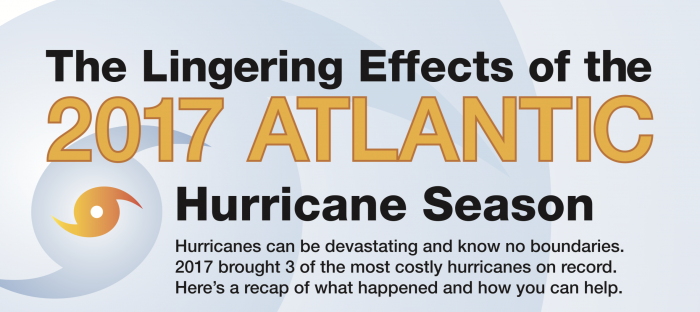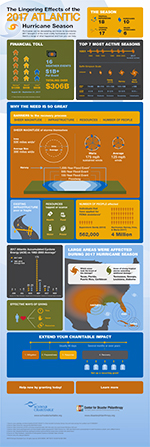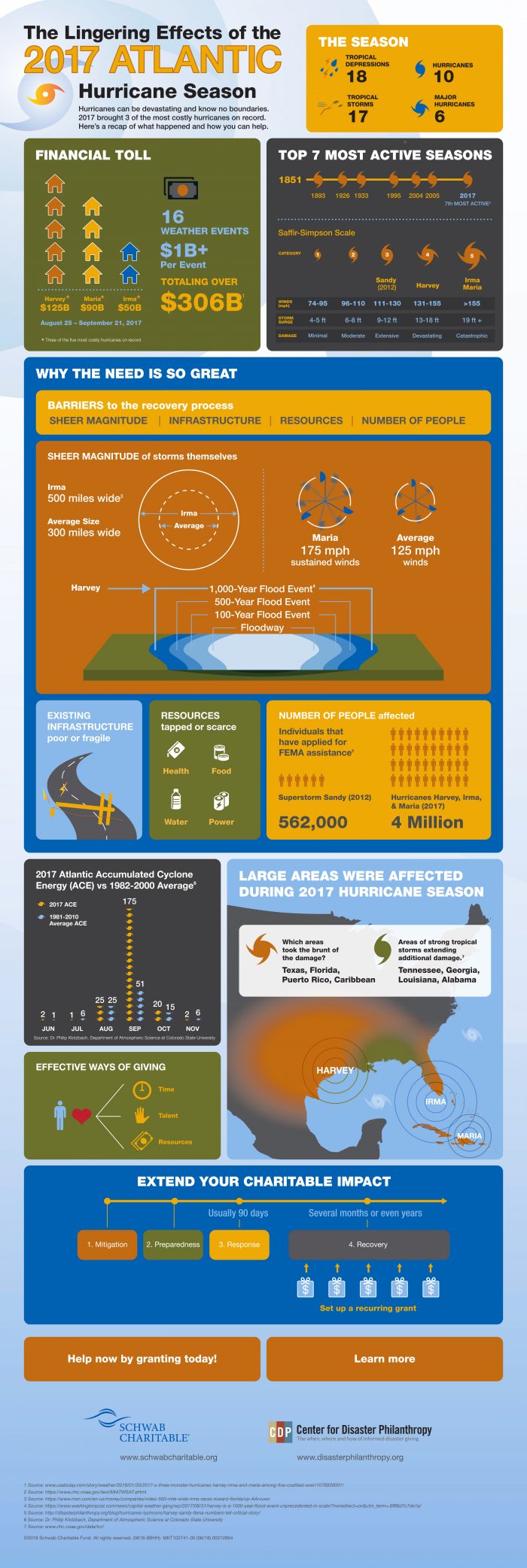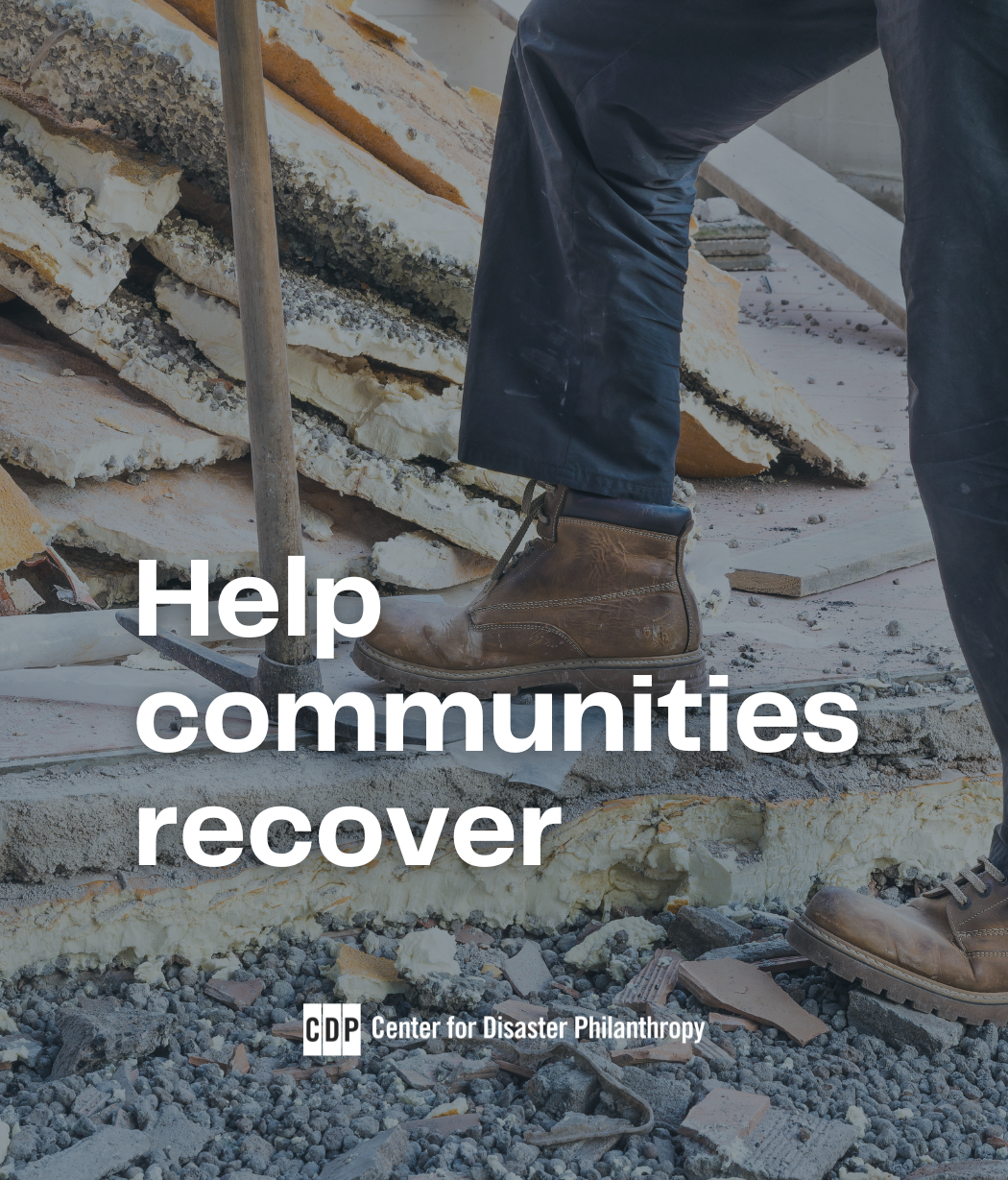Seven Things You Need to Know About the 2017 Atlantic Hurricane Season
This article first appeared on the Schwab Charitable website and is reprinted with permission. There are at least three new hurricane names that you may never forget—Harvey, Irma, and Maria. Their devastation knew no bounds dropping trillions of gallons of water on millions of homes and individuals. The damage caused by these storms (and their fellow […]

This article first appeared on the Schwab Charitable website and is reprinted with permission.

There are at least three new hurricane names that you may never forget—Harvey, Irma, and Maria. Their devastation knew no bounds dropping trillions of gallons of water on millions of homes and individuals. The damage caused by these storms (and their fellow storms Katia, Jose, and Nate) will endure for years to come. As donors generously support recovery efforts during the 2018 Atlantic hurricane season, they should not lose sight of seven facts about last year’s disasters.
- Nationwide, there were 16 weather and climate disaster events with losses topping $1 billion. The damage estimated from these 16 events totals over $306 billion. Hurricanes Harvey, Irma, and Maria, striking the United States between August 25 and September 21 are now known as three of the five most costly hurricanes on record, according to NOAA. Damage costs associated with Hurricane Harvey come to $125 billion; Hurricane Maria damages totaled $90 billion; and, Hurricane Irma damages totaled $50 billion. It was, without a doubt, the costliest year on record.
- While NOAA predicted a very active season, no one knew that it would be the fifth most active on record since 1851. The season began early, with Arlene on April 19, 2017. In total, there were 18 depressions, 17 storms, 10 hurricanes, and 6 major hurricanes. Hurricane Maria was the strongest storm of the season with winds measuring 175 miles an hour.
- The landmass affected by the 2017 Atlantic hurricane season was broad. Certainly Texas, Florida, Puerto Rico, and the Caribbean took the brunt of the damage. But the storms’ paths extended beyond those locales to include tropical storm or depression force winds in Tennessee, Georgia, Louisiana, Alabama, Mexico, Cuba, and Central America. In contrast, the 2016 Atlantic hurricane season saw much more open ocean activity, resulting in fewer landfalls and affecting less people.
- We know that disasters bring any pre-existing vulnerabilities to the forefront and the 2017 Atlantic hurricane season was no different in that regard. The devastation caused by the three largest hurricane systems has increased many issue-based vulnerabilities as well as the needs associated with distinct population groups. We know that in Harvey-affected areas, housing, the needs of undocumented immigrants and mental health are critical pressing needs. In Puerto Rico and across the Caribbean, lack of access to power, potable water, and food have been devastating to many municipalities. Over time, scarce recovery resources become scarcer, the needs of young children, older adults, undocumented immigrants, people of color, and other vulnerable populations are likely to increase.
- Regrettably, there are numerous barriers to the recovery process. The sheer magnitude of the geographies involved in the hurricane season as well as the number of people affected are putting existing systems to the test. FEMA gave the highest declaration possible to the five states affected by Superstorm Sandy. Across those five states 562,000 individuals applied for FEMA assistance. For Hurricanes Harvey, Irma, and Maria, over four million households have applied. Governmental and nongovernmental responding bodies are stretched to their limit. Existing affordable housing challenges in Houston proper and the fragility of the electrical grid in Puerto Rico before Maria hit, increase the degree of difficulty of an effective recovery process.
- Individual funders are an important and necessary part of the recovery process. The time, talents, and resources of all of us across the United States are in demand as millions of hurricane-affected families work to recover. Organizations like HandsOn and Points of Light provide guidance on how to donate your time and facilitate volunteer opportunities. Financial commitments from generous individuals to organizations undertaking the crucial recovery work means that organizations can hire staff, procure supplies, and get the good work done.
- NOAA has not yet predicted the magnitude of the 2018 Atlantic hurricane season. That said, a storm of any magnitude across the Caribbean or the Gulf of Mexico would quickly erode any recovery progress. Organizations that are members of National Voluntary Organizations Active in Disasters are actively working to attend to the immediate needs that have presented themselves following the Atlantic hurricane season—food, shelter, water, education, etc., while simultaneously working to recreate the systems that will drive community resilience for decades to come.
The 2017 Atlantic hurricane season was as real as they come—wreaking havoc across the continental U.S., the Caribbean, and to a lesser extent Mexico and Central America. There are still meaningful ways to make a difference in the lives of those affected by the storms. Straightforward financial donations to nonprofit organizations that are leading the response and recovery effort are simple and effective ways to support the recovery process.

More like this

What’s Happening with the 2017 Atlantic Hurricane Season Recovery Fund


